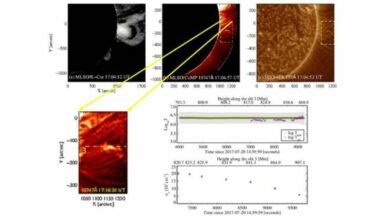NASA Partners With SpaceX To Investigate Universe

NASA elected SpaceX Falcon 9 rockets to launch the PACE (Plankton, Aerosol, Cloud, ocean Ecosystem) mission in Dec 2022
SpaceX, the private space company owned by billionaire- and, as of January 2021, the richest man in the world- Elon Musk, has once again partnered with NASA on a space-related initiative. This latest endeavour is slated to investigate the origins of the universe and map out the history of the cosmos. The mission, called SPHEREx, will involve NASA space technology and SpaceX launching capabilities. Let’s take a look at the details.
Previous Partnerships
NASA just revealed that they had chosen to award the launch contract to Elon Musk’s SpaceX. This new collaboration follows November’s launch of the Crew Dragon spaceship. The November launch was the first certified manned commercial space flight. NASA certified SpaceX to fly its astronauts just days before the official launch. The astronauts were set to dock at the ISS (the International Space Station) for six months, making the SpaceX Crew Dragon launch the longest spaceflight in American history to date. The mission was successful
The SpaceX Crew Dragon launch was the first of six proposed collaborations between NASA and SpaceX. The success of the re-launchable SpaceX Crew Dragon spaceship means that the United States now has the capacity to launch manned missions into space for the first time in almost a decade.
Alongside the Crew Dragon launch to the ISS, NASA awarded SpaceX an $80 million contract for the use of its Falcon 9 Rocket, employing the Falcon 9 to launch IMAP, an Interstellar Mapping and Acceleration Probe. IMAP will be deployed to examine the boundaries of the heliosphere, one of the magnetic barriers that surround our solar system.
This partnership came alongside several similar contracts in 2020. NASA elected SpaceX Falcon 9 rockets to launch the PACE (Plankton, Aerosol, Cloud, ocean Ecosystem) mission in December of 2022 and will employ SpaceX’s Falcon Heavy rocket to launch the NASA Psyche spaceship in July of that same year.
Launch Details
Now, NASA has chosen Musk’s SpaceX to provide launching services for SPHEREx, the Spectro-Photometer for the History of the Universe, Epoch of Reionization, and Ices Explorer mission. The mission is intended to help astrophysicists create a more detailed map of the universe and further investigate the origins of the universe.
The intended launch date for SPHEREx is scheduled to be June 2024. The telescope will be launched aboard the Falcon 9 rocket, provided by SpaceX. NASA has chosen the Space Launch Complex-4E at Vandenberg Air Force Base in California, a space launch base. The Air Force Base also hosts missile launches and STEM training course programs for students interested in expanding the competitive technological advances in the area. The SPHEREx telescope is estimated to weigh about 200 kilograms or 440 pounds. It will have the capacity to carry and transport 5-10 metric tons of cargo.
The Falcon 9 contract is set to cost nearly $99 million, among the more expensive contracts for a Falcon 9 launch. NASA had set aside approximately $120 million for the SPHEREx launch contract according to GAO, the US Government Accountability Office. This would indicate that, although relatively costly, the SpaceX contract would still be saving over $21 million in US taxpayer money set aside for the launch. The total cost of the mission is estimated to be close to $340 million.
SPHEREx Launch to Understand the Cosmos
According to a recent NASA press release, SPHEREx is intended to last for two years, with a tentative launch date set for 2024. The telescope will gather information by “survey[ing] the sky in the near-infrared light, which, though not visible to the human eye, serves as a powerful tool for answering cosmic questions involving the birth of the universe, and the subsequent development of galaxies”.
In addition to infrared surveillance, the SPHEREx telescope will seek out elements that indicate the existence of life. It will be able to detect the presence of water ice across the Milky Way, information that can point to the formation process of stars and planets. SPHEREx will also be able to discern where there are specific organic molecules that originate in areas where stars are formed out of dust and gas. These regions, called “stellar nurseries”, can also point to areas where entirely new planets could begin to form.
NASA has proclaimed that the SPHEREx mission will collect data and information about over 300 million galaxies, data that should provide answers to some of the great cosmic questions in astrophysics. The primary goal of the mission will be to understand the effects of the Big Bang on the state of the universe. The mission will also include information on the stars in our Milky Way galaxy, over 100 million of them. With the data collected from the SPHEREx investigations, astrophysicists expect to be able to piece together further details of our cosmic history. The insights provided by the SPHEREx mission could prove invaluable to our understanding of the cosmos and the history of the universe.
The post NASA Partners With SpaceX To Investigate Universe appeared first on Digpu News Network.








